Final report for OS17-102
Project Information
Peach is not only a significant economic industry in the Southeast, but it is also an important and enduring cultural icon that is under a severe threat from San Jose scale (SJS). Scale insects can damage peach orchards, both acutely and over the long-term, but for decades growers were able to inadvertently control SJS with highly effective, but potentially dangerous insecticides directed toward the primary fruit-feeding insect pests. Thus, with the loss of these effective pesticides (eg. methyl-parathion) and increased regulations on other organophosphate insecticide use, growers have to seek a more integrated pest management approach. Growers need a management strategy that more effectively utilizes environmentally friendly insecticides, such as horticultural oils, and support the beneficial insects to help naturally control scale. We therefore investigated horticultural oil volume (100, 200, and 400 gpa) and application timing (pre- and post-pruning) for improving management of SJS and their impact on insect natural enemies in southeastern peach orchards. Both application timing and oil volume were important for increasing spray coverage of peach trees. All combinations of pruning-time and volume had fewer SJS crawlers than did 100 gpa applied to pre-pruned trees. Additionally, no combination of treatments had a negative impact on insect natural enemies. Thus, if growers are able to apply their delayed-dormant oil spray post-pruning, 100 gpa may be effective at suppressing SJS crawlers, but if the oil sprays are applied prior to pruning, volumes greater than 100 gpa are needed to effectively manage SJS.
- Investigate the effectiveness of horticultural oil coverage through increased volume applied for San Jose scale suppression;
- Compare the effectiveness of horticultural oil coverage applied for San Jose scale suppression pre-peach tree pruning and post-pruning;
- Identify the natural enemy communities of San Jose scale in southeastern peach orchards and how they are impacted by management practices.
Cooperators
Research
Objective 1 and 2:
We collaborated with two commercial growers in Georgia to assess a 1.5% horticultural oil solution at three different volumes: 100 gpa, 200 gpa, and 400 gpa. These rates provide us with treatments that represent the current actual grower standard, the grower recommended standard, and the ideal standard. We assessed these three rates as applications at two different time periods in early spring 2018 as a delayed dormant application (1-5% bud swell): pre-pruning and post-pruning of the peach trees, arranged in a split-plot design. Growers were responsible for the pruning and application of oil sprays under the direction of the project team. The oil was applied to both “timings” (pre-pruned and post-pruning) on 15 February 2018.
Each of the treatment blocks were sampled at two locations (single trees) for a total of 12 sampling sites (trees) per orchard. These locations were selected every ten trees along a transect perpendicular to the border, and spread out along the row. Prior to oil application, water sensitive spray cards were deployed within each of the sampling sites to measure oil coverage between the treatments. This allowed us to measure how volume and application timing impacts direct coverage of the oil solution on the tree surface. Within the canopy of each of the sampling trees, near the base of a scale-infected branch, we hung 5, 2x3 in spray cards that turn from yellow to blue wherever water touches them. The cards were arranged with two placed on scaffold limbs closest to the row middle, one at the far side of the tree, one at the tree’s crotch, and one on the base of the trunk (Figure 1). After the oil solution was applied, we collected the cards, digitized them, and analyzed the percentage of the cards’ surface that turned blue using ImageJ image processing software. The percent coverages of the cards were arcsine transformed and compared among the treatments using analysis of variance (ANOVA), blocked by farm, and mean separation with Tukey’s HSD.
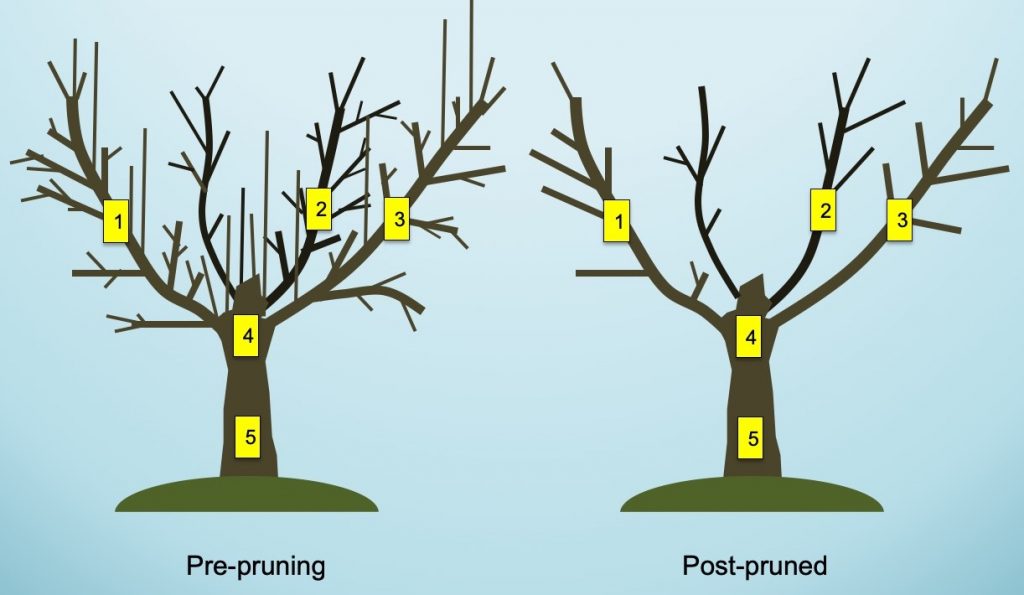
Additionally, in order to assess the impact of the delayed-dormant oil application treatments on SJS abundance, starting 25 April 2018 we monitored the abundance and activity of immature SJS (“crawlers”) on a weekly basis until harvest with a piece of double-sided sticky tape positioned over a strip of black electrical tape and wrapped around an infested branch (Figure 2). Three of these monitoring tapes were placed per sampling tree, and were removed and replaced on a weekly basis for 12 weeks. The number of SJS crawlers on a 5 cm section of tape were counted using a stereomicroscope and seasonal means were compared across the treatments. San Jose scale crawler abundances were square-root transformed and compared among the treatments using ANOVA, blocked by farm, and mean separation with Tukey’s HSD.
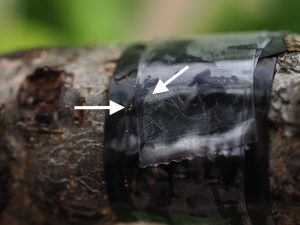
Objective 3.
In order to identify insect natural enemy communities in southeastern peach orchards and how they are impacted by delayed-dormant oil application treatments, deployed yellow sticky cards within each of the sampling trees. Traps were collected and replaced each week for 12 weeks and brought back to the laboratory. Insect natural enemies collected on the traps were counted and identified to general taxonomic levels. Total abundances of natural enemies were square-root transformed and compared among the treatments using ANOVA, blocked by farm, and mean separation with Tukey’s HSD.
Objectives 1 and 2.
Both oil volume and application timing (pre-pruning and post-pruning) were important for increasing spray coverage of peach trees. There were significant differences across the treatments (F = 7.59, df = 5,17, P = 0.0001). When applying 1.5% horticulture oil at a rate of 100 gpa, the coverage significantly increased by approximately 25% when applied post-pruning (Figure 3). Similarly, when doubling the spray volume from 100 to 200 gpa, the covereage significantly increased by nearly 30% for the pre-pruned trees and nearly 20% for the post-pruned trees. Additionally, at 200 gpa, applying the oil post-pruning compared to pre-pruning significantly increased coverage by 18% (Figure 3). At 400 gpa, the covereage significantly increased by 32% for the pre-pruned trees and 44% for the post-pruned trees compared to 100 gpa applied to pre-pruned trees. Comparing pre-pruning with post-pruning application of oil at 400 gpa, there was a marginal increase in coverage, but was not significant (Figure 3).
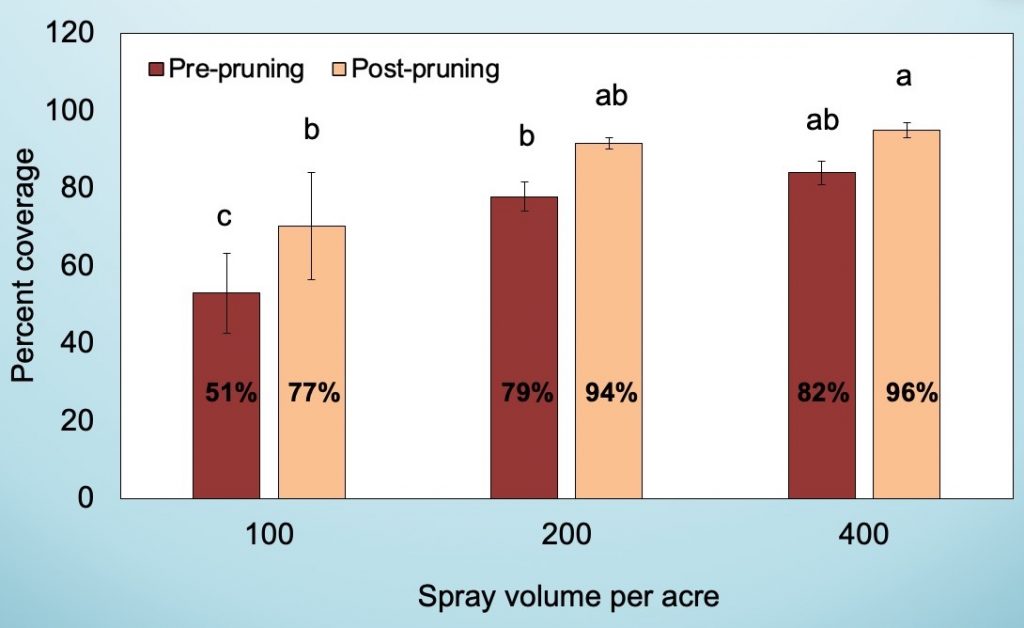
Coverage is important because horticultural oil manages SJS through directly smothering the scale insects, so it is expected that the better the coverage, the better the control of SJS. Through our sampling of scale crawlers, this expectation appears to be true. The application of 100 gpa of 1.5% oil to pre-pruned trees had the lowest percent coverage, which in turn, also had the highest abundance of scale crawlers. All combinations of volume and pruning-time had fewer crawlers than did 100 gpa applied to pre-pruned trees (Figure 3). Overall, applying horticultural oil to post-pruned trees significantly reduced the number of SJS crawlers collected on the trees, but while numerically lower, there was no significant decrease in SJS crawlers as the volume of oil applied to post-pruned trees increased (Figure 4).
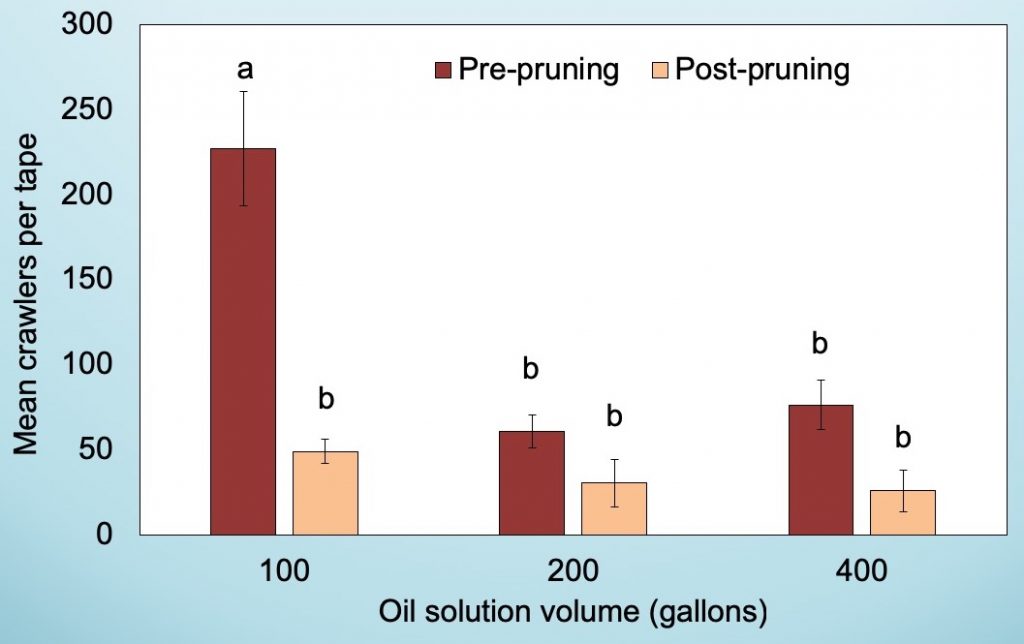
Objective 3.
A total of 1,782 insect natural enemies were collected on the yellow sticky cards at the two peach orchards. The majority of the natural enemies were within the parasitoid group (parasitic wasps), but were not necessarily parasitoids of SJS. The other groups in the five most abundance natural enemies collected were generalist predators – minute pirate bugs, long-legged flies, spiders, and lady beetles – which have the potential to feed on SJS (Figure 5). Lady beetles, which made up 3% of the total natural enemies, can be highly effective control agents for scale insects. Additionally, when assessing the abundances of natural enemies there was no differences among the average abundances (F = 0.47, df = 5,30, P = 0.797), meaning no combination of treatments had a negative impact on insect natural enemies.
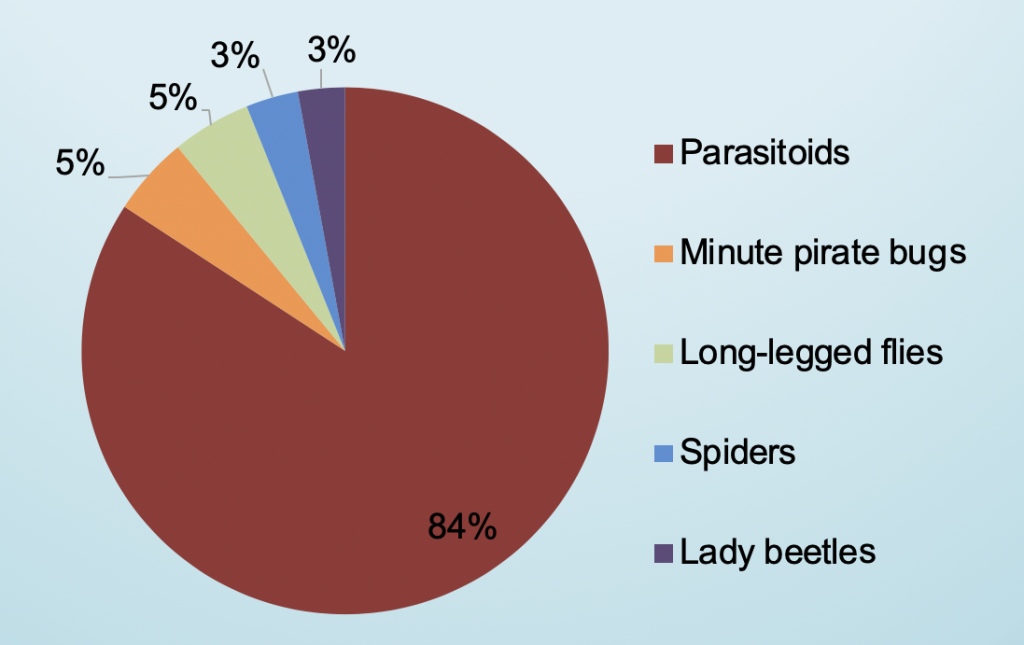
Discussion:
We investigated horticultural oil volume (100, 200, and 400 gpa) and application timing (pre- and post-pruning) at delayed-dormant for improving management of SJS and their impact on insect natural enemies in in southeastern peach orchards. Both oil volume and application timing were important for increasing spray coverage of peach trees, which subsequently impacted the abundance of SJS crawlers. All combinations of volume and pruning-time had fewer SJS crawlers than the 100 gpa applied to pre-pruned trees. Additionally, no combination of treatments had a negative impact on insect natural enemies. Thus, if growers are able to apply their delayed-dormant oil spray after they have pruned their trees, 100 gpa may result in sufficient coverage to be effective at suppressing SJS crawlers. On the other hand, if the oil sprays are applied prior to pruning, volumes greater than 100 gpa, nearing 200 gpa are needed to sufficiently cover the trees to effectively manage SJS. Applying volumes upward of 400 gpa do not seem to significantly improve management of SJS and are thus not recommended in the Southeast.
Educational & Outreach Activities
Participation Summary:
Brett R. Blaauw. The scale of the problem: Evaluating IPM in southeastern peach production. Entomological Society of America – Southeastern Branch Annual Meeting, March 6, 2019, Mobile, AL.
Brett. R. Blaauw. Insect Pest Management Update: San Jose scale. Annual Georgia Commercial Peach Production Meeting. February 7, 2019, Reynolds, GA.
Brett. R. Blaauw. Insect Pest Management Update. Annual Upstate SC Commercial Peach Production Meeting. January 22, 2019, Chesnee, SC.
Brett. R. Blaauw. Insect Pest Update and a Forecast for the 2019 Season. Southeast Regional Fruit and Vegetable Conference. January 11, 2019, Savannah, GA.
Brett R. Blaauw. Southeastern Peach Pests. 2018 Brooks County Peach Meeting. December 6, 2018, Quitman, GA.
Vegetable and Specialty Crop News: Peach Pruning Improves San Jose Scale Control (http://vscnews.com/peach-pruning-improves-san-jose-scale-control/)
Learning Outcomes
Application volume and timing of delayed-dormant oil for San Jose scale management
Project Outcomes
The previous recommendations for San Jose scale management in Southeastern peach production was applying 200 gpa of 1.5% horticultural oil solution at delayed-dormant. We determined that if growers are able to apply their delayed-dormant oil spray after they have pruned their trees, 100 gpa may result in sufficient coverage to be effective at suppressing SJS crawlers. On the other hand, if the oil sprays are applied prior to pruning, volumes nearing 200 gpa are needed to sufficiently cover the trees and effectively manage SJS. Applying volumes upward of 400 gpa do not seem to significantly improve management of SJS and are thus not recommended in the Southeast. These results will help growers better manage SJS while also saving time and money in terms of oil applications.